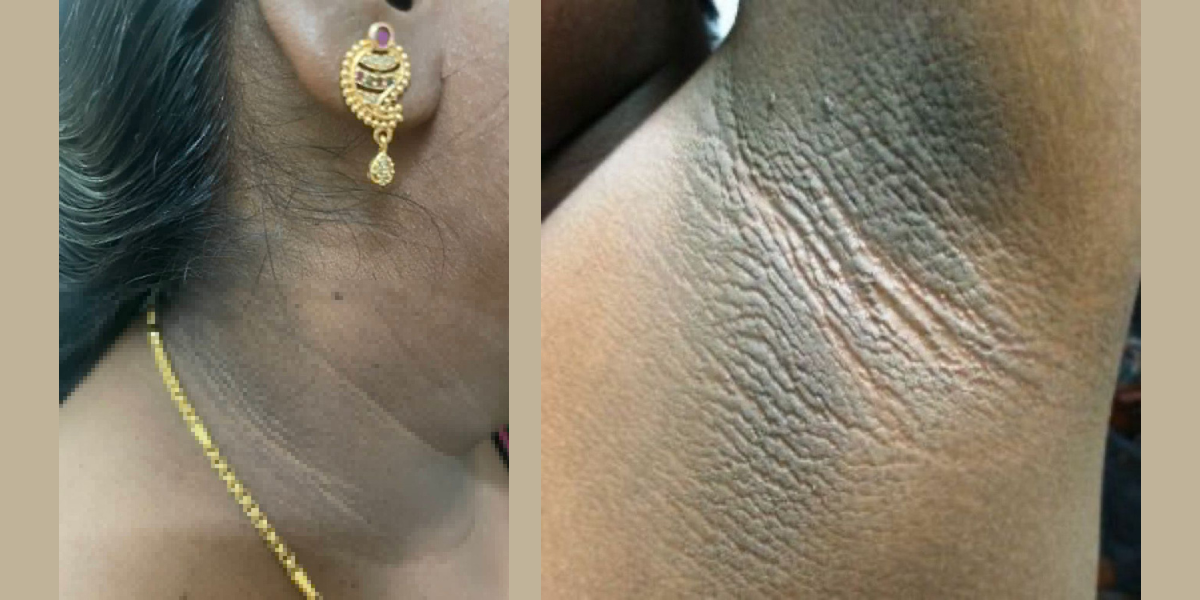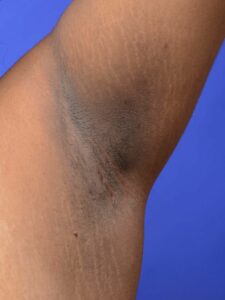Acanthosis nigricans is a skin condition that appears as dark, velvety patches around the neck, armpits, groin, and sometimes elbows and knees.

While acanthosis nigricans itself is not a disease, its presence is indicative of an underlying condition that warrants evaluation. (Twitter)
Have you noticed dark, velvety skin around your neck or your child’s neck? If you have, it might be more than just a cosmetic concern. This condition, known as acanthosis nigricans, could be an indication of underlying health issues like insulin resistance and diabetes.
Leading diabetologist and chairman of Dr Mohan’s Diabetes Specialties Centre and Madras Research Foundation, Dr V Mohan tells South First, “The soft, velvety fold-like thing that you see on the neck occurs mostly in people with obesity, both in adults and in children. This is definitely an indication of insulin resistance.”
He also adds that it is increasingly occurring in youngsters, children, and adolescents and is tied to the proportionate increase in obesity across the country.
Acanthosis nigricans is a skin condition that appears as dark, velvety patches primarily around the neck, but also in the armpits, groin, and sometimes the elbows and knees.
Doctors explain that the affected skin may feel thicker or raised compared to the surrounding areas. While it’s not a disease on its own, it serves as a visible indicator of an underlying medical condition.
“This is, in fact, a major indication for us to diagnose whether someone is obese or insulin resistant,” Dr Mohan says.
Recently, several endocrinologists and dermatologists took to Twitter to warn the public about this indication. Endocrinologist Dr Lakshmi Nagendra recently tweeted, “This patient came with cosmetic concerns and was diagnosed with diabetes. This dark, velvety patch that usually appears in the armpits, neck or groin is known as acanthosis nigricans, and could be a harbinger for underlying diabetes and metabolic disorders. Get yourself tested!”
This patient came with cosmetic concerns and was diagnosed with diabetes. This dark velvety patch that usually appears in the armpits, neck or groin is known as Acanthosis nigricans and could be a harbinger for underlying diabetes and metabolic disorders. Get yourself tested! pic.twitter.com/ZyYp3YQ2FZ
— Dr Lakshmi Nagendra MD,DM (ENDO) (@idrlakshmi) May 4, 2023

Insulin resistance, that physically manifests as acanthosis nigricans, can lead to type 2 diabetes. (Commons)
According to doctors, insulin resistance occurs when the body’s cells do not respond effectively to insulin, a hormone that helps regulate blood sugar levels.
To compensate, the pancreas produces more insulin, leading to higher levels in the bloodstream. This excess insulin stimulates the growth and multiplication of skin cells, resulting in the appearance of acanthosis nigricans.
Dr Mohan adds that insulin resistance also plays a significant role in the development of type 2 diabetes. Over time, the pancreas becomes unable to maintain sufficient insulin production, leading to consistently high blood sugar levels.
If not managed properly, this can progress to type 2 diabetes, a chronic condition where the body struggles to regulate blood glucose levels effectively.

Most people with acanthosis nigricans visit a dermatologist for cosmetic reasons. (Wikimedia Commons)
Dr Sanchita Phule, a dermatologist from Bengaluru, weighs in, “In many Indian families, the presence of dark skin around the neck is often dismissed as a result of poor hygiene or dirt accumulation. It is rarely associated with diabetes and is mostly handled by dermatologists.”
In this regard, she adds that it is important for dermatologists to carefully examine the patient and if obesity, family history of diabetes, sedentary lifestyle is noted, then they must refer them to an endocrinologist.
Especially in children and those with darker skin tone, it is normally associated with dirt patches. However, Dr Mohan says that “factors contributing to these conditions in children include obesity, lack of physical activity, poor diet, and a family history of diabetes. If your child has acanthosis nigricans, it’s important to take it as an early warning sign and make necessary lifestyle changes to prevent future complications.”
For girls, it could also indicate polycystic ovarian syndrome (PCOS), where they may experience irregular periods among other symptoms. It is to be noted that women with PCOS are often insulin resistant.
To address this issue, doctors say that it is vital to promote awareness and education among Indian families.
If noticed early, Dr Manohar KN, Chairman of Research Society for the Study of Diabetes in India (Karnataka Chapter), says acanthosis nigricans can be reversible.
He advices, “Patients should be instructed that acanthosis nigricans is not a skin disease per se, but rather a sign of an underlying problem. If a patient does have acanthosis nigricans on the basis of insulin resistance, treatment of the metabolic abnormality may lead to improvement of the appearance of the skin. Dietary changes and weight loss may cause the condition to regress almost completely.”
Dr Mohan also adds that if someone with acanthosis nigricans cuts down on carbohydrates, starts to exercise, and makes positive lifestyle changes, this condition can be reversed.

Jul 26, 2024

Jul 26, 2024

Jul 26, 2024

Jul 26, 2024

Jul 25, 2024

Jul 25, 2024